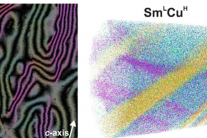Improving High-Performance Magnets by Nano-Engineering
Tue, 05/11/2021 - 10:02amSamarium-Cobalt Sm(Co,Fe,Cu,Zr)z magnets are essential materials in high-temperature applications, such as turbomachinery and energy conversion, and their performance strongly depends on the microstructure, which is characterized by an intricate network of Sm2Co17 cells partitioned by SmCo5 cell-walls. In study published in the Journal of Applied Physics (link), an international team of physicists and material scientists studied different SmCo magnets using transmission electron microscopy, electron holography to image the magnetic field in the material (left part of figure), and atom-probe tomography (right part of figure), in order to understand the connection between their nanostructure and magnetic performance. The team found that magnetization reversal in SmCo magnets is dominated by magnetic processes at SmCo5 cell walls. At low temperatures, magnetic textures are pinned to the SmCo5 walls hindering the magnetization reversal, but at high temperatures magnetization reversal starts at the SmCo5 cell walls. Based on this, it is proposed how the SmCo5 cell walls should be engineered, especially in relation to the Cu concentration gradient, in order to improve the magnetic performance of Sm(Co,Fe,Cu,Zr)z magnets. This has important implications for the future of energy conversion in terms of material resource sustainability.
A new paper regarding this was just published in the Journal of Applied Physics.

